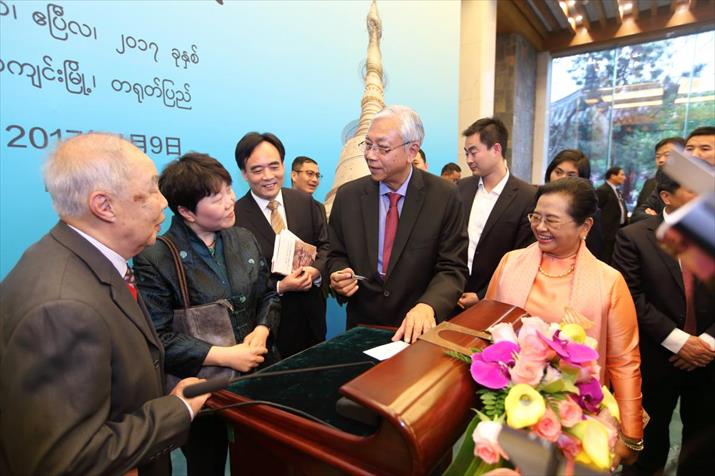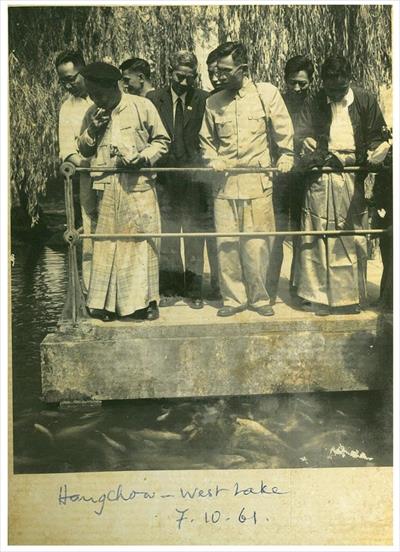| Lifestyle |
| Bridge of Words | |
| Bilingual collection of Myanmar scholar's select works opens another window between neighbors | |
|
|
 Myanmese President U Htin Kyaw (middle) attends the launch ceremony of the book Min Thu Wun's Affinity With China in Beijing on April 9 (XU XUN)
"Ask a Myanmar people who's the most influential Myanmar author alive, or ask a scholar of Southeast Asian literature who's the most representative Myanmar author and you'll get the same answer: 89-year-old man of letters Min Thu Wun." This is how Li Mou opens his article A Review of Famous Modern Writer Min Thu Wun, which was written in 1997 and published in the English-Myanmar bilingual magazine The International in 2004, the year the academic passed away at the age of 95. Li, a professor at the Myanmar Research Center of Yunnan University in southwest China, is also a former student of Min Thu Wun. Min Thu Wun's works go beyond the scholastic. His rendition of works from Chinese into Myanmar has contributed to cultural exchanges between the two countries. Min Thu Wun's Affinity With China, a collection of the author's works, comprising translations of classic and modern Chinese poetry, folk tales and crosstalk dialogues, as well as his views on China, was released in Beijing on April 9. The book, both in Chinese and Myanmar, has been published by the Foreign Languages Press (FLP), an international publishing house that is part of the China International Publishing Group (CIPG). "My father was fond of the Chinese culture and language," Min Thu Wun's son, Myanmar President U Htin Kyaw, said at the book launch. "I hope his work can play a positive role in Myanmar-China exchanges." Expressing his appreciation for the scholar and the book, CIPG Vice President Lu Cairong said, "With his delicate words, Min Thu Wun built a bridge of communication between our two peoples. In terms of promoting bilateral friendly exchanges, he is a paragon for the literati of both countries."  Min Thu Wun (second left) and his delegation visited Hangzhou, east China's Zhejiang Province, in 1962 (COURTESY OF FOREIGN LANGUAGES PRESS)
Different strokes Many Chinese works were introduced in Myanmar at the end of the 1940s and the beginning of the 1950s, exerting considerable influence on the Southeast Asian country's literary circles. They exposed Min Thu Wun to Chinese literary thoughts and in 1956, he wrote an article on Lu Xun (1881-1936), one of China's most influential writers in the first half of the 20th century, and introduced Lu's writing to Myanmar readers. As a poet himself, Min Thu Wun was fascinated by Chinese classical poetry. One of his favorite Chinese poets was Tang Dynasty poet Bai Juyi (772-846). "It is surprising that he could translate Chinese literary works so well even though he didn't know Chinese," Li said, recollecting a meeting with Min Thu Wun while he was working at the Cultural Office of the Chinese Embassy in Yangon in 1988. "I helped him to jot down the pronunciation, meaning and background information of one of Bai's poems. He translated it into his language in a neat and balanced form with a melodious and harmonious sound to it. It was amazing!" Min Thu Wun's published Chinese-Myanmar translations cover many genres, including a modern poem by late Chinese Vice Premier Chen Yi (1901-72) on China-Myanmar friendship written during his trip to Myanmar in 1957, a script of well-known crosstalk artist Hou Baolin (1917-93) and Chinese folk tales. "Min Thu Wun was a master of the Myanmar language," Li said in tribute. "Every word he used was the product of deliberate thinking." Li studied at the University of Yangon from 1958 to 1962, where he met Min Thu Wun, little knowing then that one day he would become one of the editors of the commemorative Min Thu Wun's Affinity With China. Min Thu Wun visited China in the 1960s. During his lifetime, his rendering of Chinese literary classics into Myanmar, many of which are included in the collection, enabled Chinese literary thoughts to gain appreciation among Myanmar's literati. Li said the book can serve as a reminder for both Chinese and Myanmar that there were people like Min Thu Wun, who laid the foundation of friendship between the two countries. "We should build on their achievement and do more to promote our exchanges and create a brighter future," he added. "The collection is a dialogue of the two civilizations," Zhu Xianghui, one of the book's editors and associate professor at the Institute of International Studies of Yunnan University, told Beijing Review.
The book cover of Min Thu Wun's Affinity With China (COURTESY OF FOREIGN LANGUAGES PRESS)
Connecting hearts There were others like Min Thu Wun who contributed to the bilateral cultural exchanges by helping Chinese people learn more about Myanmar. Chinese writer Ai Wu (1904-92) wrote about his impression of Myanmar scenery while journalist Huang Chuoqing (1911-72) wrote many articles about the country while he lived there. Today, a large volume of literary works from both countries are being translated into each other's languages and there are many people who have mastered both the languages, or are working in each other's country. But the interactions are still far from enough. "Our cultural exchanges are expanding, but we need more than that," Zhu said, adding that China should provide Myanmar authors more opportunities for cooperation. "We should introduce the real China to Myanmar people," he said. "High-level figures from both countries should do more to continue our friendly dialogues that have lasted for more than a thousand years," Li echoed Zhu. Such an endeavor is underway. With the establishment of diplomatic relations between China and Myanmar on June 8, 1950, there have been more than 600 large-scale cultural exchange visits between the two sides. Since the Asia Arts Festival was initiated in Beijing in 1998, Myanmar's national art troupe has been a regular invitee to the event. With the Silk Road Economic Belt and the 21st-Century Maritime Silk Road (Belt and Road) Initiative gaining momentum, more measures will be taken to boost China-Myanmar cultural exchanges. In January, the Chinese Ministry of Culture released an action plan for cultural development along the Belt and Road routes, prioritizing establishing China cultural centers in countries such as Myanmar, Malaysia and Indonesia to create a platform for exchanges and cooperation. "As two important countries along the Belt and Road, China and Myanmar are working with each other closely for the initiative," Hong Liang, Chinese Ambassador to Myanmar, told Beijing Review. "The most important thing is to connect the two people's hearts through people-to-people exchanges." Copyedited by Sudeshna Sarkar Comments to luyan@bjreview.com |
|
||||||||||||||||||||||||||||
|